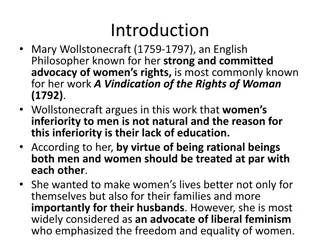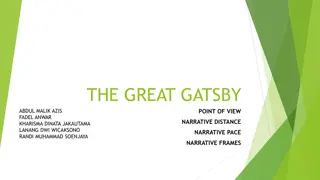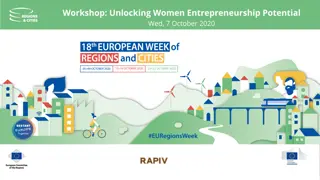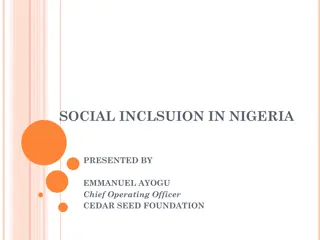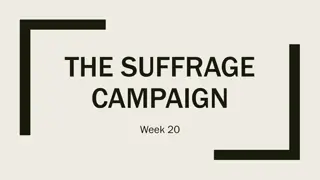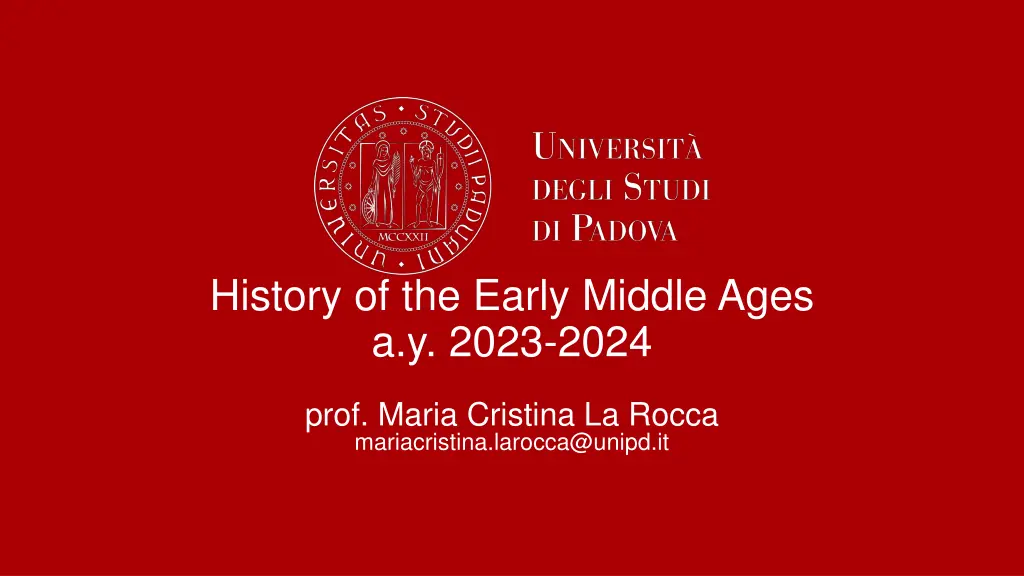
Women in Early Middle Ages Narratives
Explore the portrayal and roles of women in narratives dating between the 7th and 8th centuries, shedding light on the evolving Christianization of gender representations and the limited space for female characters. Delve into stories like the Origo Gentis Langobardorum, showcasing strong female figures like Gambara. Uncover historical accounts of women's contributions, challenges, and agency during this transformative era.
Uploaded on | 2 Views
Download Presentation

Please find below an Image/Link to download the presentation.
The content on the website is provided AS IS for your information and personal use only. It may not be sold, licensed, or shared on other websites without obtaining consent from the author. If you encounter any issues during the download, it is possible that the publisher has removed the file from their server.
You are allowed to download the files provided on this website for personal or commercial use, subject to the condition that they are used lawfully. All files are the property of their respective owners.
The content on the website is provided AS IS for your information and personal use only. It may not be sold, licensed, or shared on other websites without obtaining consent from the author.
E N D
Presentation Transcript
History of the Early Middle Ages a.y. 2023-2024 prof. Maria Cristina La Rocca mariacristina.larocca@unipd.it
Clearing out women (7-8 century) The narratives dated between the 7 and 8 century tend to mention women less and less. This is valid in the Eastern part of the Roman Empire and in the Barbarian West. As Leslie Brubaker has stated: As expressed in the sources, gender roles became increasingly Christianised after the reign of Justinian. While there were considerable restrictions on women s and men s role in the gender representations of Justinian s reign, there was actually more space for especially female action than during the next two centuries. More and more, the Christian imagery in our sources tends to exclude women, whatever they actually did. If Procopious admitted woman as a character type on the Byzantine stage, we will not find women again in this role for two hundreds years .
Women and narratives of origins Origo gentis Langobardorum (620 ca.) In the name of God, here begins the origin of the Lombard people. There is an island in the northern regions called Scadanan, which means 'destruction', which many peoples inhabited. Among them was a small people who were called Winnili. And with them was a woman whose name was Gambara who had two sons. Ybor was the name of one and Aio the name of the other. Together with their mother Gambara they ruled over the Winnili. Paul The Deacon , Historia Langobardorum book 3 (after 774) Therefore that section to which fate had assigned the abandonment of their native soil and the search for foreign fields, after two leaders had been appointed over them, to wit: Ibor and Aio, who were brothers, in the bloom of youthful vigor and more eminent than the rest, said farewell to their own people, as well as their country, and set out upon their way to seek for lands where they might dwell and establish their abodes. The mother of these leaders, Gambara by name, was a woman of the keenest ability and most prudent in counsel among her people, and they trusted not a little to her shrewdness in doubtful matters.
Origo Gentis Langobardorum Then the Vandal chiefs, Ambri and Assi, came with their armies and said to the Winnili: "Either you pay us tribute or you must prepare for war to fight with us. Then Ybor and Aio, together with their mother Gambara, replied: "It is better to prepare for battle than to pay tribute to the Vandals". Paul the Deacon, Historia Langobardorum, b. 7 The Winnili then, having departed from Scandinavia with their leaders Ibor and Aio, and coming into the region which is called Scoringa, settled there for some years. At that time Ambri and Assi, leaders of the Wandals, were coercing all the neighboring by war. Already elated by many victories they sent messengers to the Winnili to tell them that they should either pay tribute to the Wandals or make ready for the struggles of war. Then Ibor and Aio, with the approval of their mother Gambara, determine that it is better to maintain liberty by arms than to stain it by the payment of tribute. They send word to the Wandals by messengers that they will rather fight than be slaves. The Winnili were then all in the flower of their youth, but were very few in number since they had been only the third part of one island of no great size.
Origo gentis Langobardorum Then Ambri and Assi who were the Vandal leaders asked Godan to give them victory over the Winnili. Godan's answer was "To those I see first at dawn I will give victory". Paul the Deacon, Historia Langobardorum, b. 8 At this point, the old men tell a silly story that the Wandals coming to Godan (Wotan) besought him for victory over the Winnili and that he answered that he would give the victory to those whom he saw first at sunrise.
Origo gentis Langobardorum Then Gambara and his two sons, Ybor and Aio, who ruled over the Winnili, begged Frea, the wife of Godan, to intercede for the Winnili. So Frea advised the Winnili to arrive at dawn with their women, with their hair pulled back around their faces as if they were beards. When it began to dawn, as the sun was rising, Godan's wife Frea turned the bed where her husband was sleeping, turned his head to the east and woke him up. Paul the Deacon, Historia Langobardorum, b. 8 (the old men tell a silly story) that then Gambara went to Frea wife of Godan and asked for victory for the Winnili, and that Frea gave her counsel that the women of the Winnili should take down their hair and arrange it upon the face like a beard, and that in the early morning they should be present with their husbands and in like manner station themselves to be seen by Godan from the quarter in which he had been wont to look through his window toward the east. And so it was done.
Origo gentis Langobardorum He said, "Who are these long beards?" And Frea said to Godan, "Now that you have given him the name, give him also the victory." And he gave them victory. From then on the Winnili were called Lombards. Paul the Deacon, Historia Langobardorum, b. 8 And when Godan saw them at sunrise he said: "Who are these long-beards?" And then Frea induced him to give the victory to those to whom he had given the name. And thus Godan gave the victory to the Winnili. These things are worthy of laughter and are to be held of no account. For victory is due, not to the power of men, but it is rather furnished from heaven.
Andrew of Bergamo, Historia (850 ca.) In the northern part of Europe on the borders of Germany there is an island called Scandinavia. In it, given the multitude of peoples living there, we read of a people called Winoli, who inhabited a third part of it. At their head were two dukes, Hibor and Agio with their mother Gambara. They left Scandinavia and went to an island called Scoringa, where they resided for many years. They were the Winoli of youths, with flowing beards, and to look more numerous, their women also put their hair around their faces, as if it were a beard. And for this they were called Langobards. Paul the Deacon, Historia Langobardorum, b. 9 It is certain, however, that the Langobards were afterwards so called on account of the length of their beards untouched by the knife, whereas at first they had been called Winnili; for according to their language "lang" means " long" and " bart " "beard." Wotan indeed, whom by adding a letter they called Godan is he who among the Romans is called Mercury, and he is worshiped by all the peoples of Germany as a god, though he is deemed to have existed, not about these times, but long before, and not in Germany, but in Greece. The Winnili therefore, who are also Langobards, having joined battle with the Wandals, struggle fiercely, since it is for the glory of freedom, and win the victory. And afterwards, having suffered in this same province of Scoringa, great privation from hunger, their minds were filled with dismay.
Militarisation of Society 7 century The concept of militarisation is useful when considered as a process that is neither linear nor mono-causal, but linked to a society as a whole, thus allowing for the analysis of its changes without postulating a dichotomy between civilised Romans and warlike barbarians. The legal codes drawn up in the 6th and 7th centuries presuppose a general obligation of free adult men to perform military service. Written and archaeological sources attest to the high esteem attached to the military role, and the identity ideas of virility (virilitas) and utility (utilitas) are strongly linked to military skills. The community responsible for these burials attached great importance to the military identity of their dead.
The Lombards as a militarised society By a militarised society I mean a society in which 1. there is not clear distinction between a soldier and a civilian, nor between military officer and government official; 2. where the head of state is also a commander in chief of the army; 3. where all adult free men have the right to carry weapons; 4. where the education of the young often involves a military element; 5. where the symbolism of warfare and weaponry is prominent in official and private life" (E. James, The militarisation of Roman society, 400 700 , 1997). 1. the most important offices, such as the duces and gastaldi; 2. The king, head of the society, was also the supreme commander of the army and usually participated personally in campaigns; 3. there was a widespread proliferation of weapons in large parts of the free male population that were expected to serve in the army; 4. there was a high level of recognition of military capabilities, activities and values; 5. weapons were not only used in warfare, but also for certain ceremonies and rituals, having some symbolic meaning; i.e., the handing over of a lance to a chosen candidate on the occasion of his accession to the throne
5.Certain classes (notably the aristocracy) are expected to participate in the army. 6. Education includes a military element. 7. The symbolism of weaponry is prominent in official and private life. 8. Warlike and heroic virtues are glorified. 9. Warfare is a major expenditure and source of profit (booty).
Who was obliged to serve in their armies? In view of a 200-year history of the Lombards in Italy, it can hardly be supposed that in terms of militarisation a static and homogeneous picture emerges. Rather, different trends and developments are observable, leading to the sources depicting differing degrees of militarisation. An undeniable difficulty: in fact only a small section of the entire Italian society can be analysed in some detail due to the perspectives of the surviving written sources. With the exception of Paul the Deacon s Historia Langobardorum, we lack any coherent narrative of noteworthy length between the end of the sixth and the end of the eighth centuries. In addition to increasing militarisation tendencies, in the early years of the Lombard s presence in Italy, demilitarisation trends are also discernible, especially in the final decades of the Lombard kingdom.
The Lombards between military and landed aristocracy. Spatial factors likely played a considerable role. In border duchies, as for instance Friuli, a higher degree of militarisation can be observed than in regions that were only occasionally affected by armed conflict. This indicates that sometime between the invasion of 568 and before 643, Lombard warriors had made use of opportunities to acquire land (as hospites), thus retaining their military obligations. The arimanni (Lomb.) or exercitales (Lat.) were organised corporately as free men fighting for their rex or dux, for their people and their territory. From the Lombard leges, landed wealth became increasingly important during the seventh century. The Edictum Rothari and the laws of subsequent kings present the Lombards as landowners in many of their chapters.








